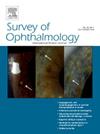Diabetic uveopathy
IF 5.1
2区 医学
Q1 OPHTHALMOLOGY
引用次数: 0
Abstract
Diabetes can involve several ocular structures -- including the cornea, lens, and retina -- and cause vascular and neural changes in these tissues. Although retinopathy is the most common ocular complication of diabetes, uveopathy can also be observed. This includes vascular, neural, muscular, and basement membrane changes. The main clinical manifestations of diabetic uveopathy are anterior uveitis and abnormal pupillary dynamics. Fluorescein angiography, optical coherence tomography, and optical coherence tomography angiography are ideal for the imaging of vascular changes of the iris and choroid, while dynamic pupillometry is a simple screening tool to detect neuropathy. Additionally, ultrasound biomicroscopy can provide clear images of the ciliary body. Iris abnormalities, primarily angiopathy and neuropathy, can appear as alterations in vascular diameter, neovascularization, and abnormal pupillary dynamics. Choroidal abnormalities primarily affect blood vessels, including alterations in vascular diameter, microaneurysm formation, and neovascularization. The abnormal manifestations in the ciliary body include a decrease in vessel count, alterations in their diameter, isolated angiomatous dilatation, and diffuse thickening of the basal membrane of the pigment epithelium.
糖尿病葡萄膜病变
糖尿病可累及多种眼部结构,包括角膜、晶状体和视网膜,并引起这些组织的血管和神经变化。虽然视网膜病变是糖尿病最常见的眼部并发症,但也可观察到葡萄膜病变。这包括血管、神经、肌肉和基底膜的变化。糖尿病葡萄膜病变的主要临床表现是前葡萄膜炎和瞳孔动态异常。荧光素血管造影术、光学相干断层扫描和光学相干断层血管造影术是虹膜和脉络膜血管病变成像的理想方法,而动态瞳孔测量则是检测神经病变的简单筛查工具。此外,超声生物显微镜还能提供清晰的睫状体图像。虹膜异常,主要是血管病变和神经病变,可表现为血管直径改变、新生血管形成和瞳孔动态异常。脉络膜异常主要影响血管,包括血管直径改变、微动脉瘤形成和新生血管。睫状体的异常表现包括血管数量减少、血管直径改变、孤立的血管瘤扩张和色素上皮基底膜弥漫性增厚。
本文章由计算机程序翻译,如有差异,请以英文原文为准。
求助全文
约1分钟内获得全文
求助全文
来源期刊

Survey of ophthalmology
医学-眼科学
CiteScore
10.30
自引率
2.00%
发文量
138
审稿时长
14.8 weeks
期刊介绍:
Survey of Ophthalmology is a clinically oriented review journal designed to keep ophthalmologists up to date. Comprehensive major review articles, written by experts and stringently refereed, integrate the literature on subjects selected for their clinical importance. Survey also includes feature articles, section reviews, book reviews, and abstracts.
 求助内容:
求助内容: 应助结果提醒方式:
应助结果提醒方式:


